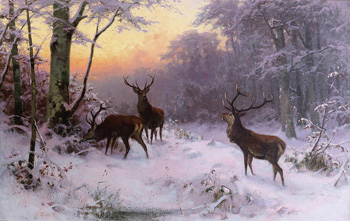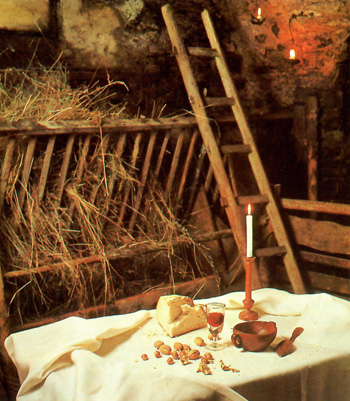Catholic Customs
 |
 |
 |
 |
 |
 |
 |
The Wonders of Christmas Night

and all that is under heaven
greet this the Author of their new salvation
with a new canticle.
(Excerpt from Jesu, Redemptor Omnium)
When midnight, that long awaited hour, finally arrives, the earth sings a new canticle to her Infant King by producing many marvels: Hidden gems reveal themselves from the depths of mountains, trees burst into blossom and fruit, church bells ring from cities that sit on the bottom of the sea, and the sun jumps thrice for joy. (1)
The marvels of the Heavens
Heaven bursts open revealing its treasures and the Son of God Himself descends to earth, according to Eastern European peoples. Many Greek and Russian peasants would stay up all night to see this wonder and make a wish, for it was said that any wish made at midnight would come true. (2) The Poles too believed that the heavens opened to reveal the scene of Jacob’s ladder, but only a saint could view such a marvel. (3)

Medieval women admiring the Heavens
The nearness of Heaven brings new marvels to the earth. The water that flows from rivers and springs during the hour of Our Lord’s birth is said to be blessed. There are even ancient tales told that river water turns to wine and is given miraculous healing powers from the rivers of Paradise, which come alive and awaken earth’s streams.
Greek women visited the springs and wells at dawn to collect this cherished water. That water was often used to make the new batch of yeast for the year. In Epirus, the women mixed flour with the water and place it in their kneading trough, while saying three times: “Christ is born, the light is rising – so that my yeast may be good.” (5)

The menhirs fly to the ancient springs to drink the pure water.
In the Hungarian village of Fornos, girls and boys decorated the village well with evergreen boughs; at midnight they drew water from the well for they believed that the Christ Child bathed in it, imparting to it healing qualities. On the way home from Midnight Mass, every family drank from this well and washed their faces and hands with its water. (6)
In Brittany as the bells ring for Midnight Mass, ancient standing stones called menhirs are said to release themselves from the earth to drink from the ancient springs. Some people say that the menhirs lay atop secret treasures that are only revealed during the menhir’s short flight in the air. When the church bells stop tolling, the menhirs return to their former places, as immovable as before. (7)
The animals’ adoration
The earth, overflowing with the new blessings from Heaven, transfers its joy to the animals that are keenly aware of the wondrous nature of this night.

The stag, King of the forest, first to sense the wonder of Christmas night
Safe in their warm stables, the farm animals are said to face east and fall on their knees at midnight and to be given the gift of language, according to old legends. And in the fields Old English shepherds reported seeing the sheep honoring the shepherd’s journey by going in procession on this night. (10)
Joining this chorus of praise are the creatures of the air. The English and Irish say that the bees awaken from their winter sleep at midnight to hum the 99th Psalm, Jubilate Deo, to greet the Newborn King; (11) and some peoples defend the legend that the Cock crows the whole night to scare away evil spirits. (12)
The heavenly denizens come to earth
The wonders that the natural world produces on this Holy Night prepare the earth to receive Heavenly visitors. In ages of Faith, when the angelic world was more present and miracles were common, it is easy to believe that the Angels and the Saints truly did visit this earth freely on the Holiest Night of the Year. Perhaps such miracles continue in unknown areas even in these times.

Shepherds stand in awe at the tidings of the Angels
Spaniards from mountain regions welcomed Our Lady by leaving the hearth filled with red-hot embers so that she might warm herself as she travelled with her child. Sometimes a chair was set by the fire for Our Lady to sit upon. Early on Christmas morning, the children hurried to the hearth where they searched for Our Lady’s footprints in the ashes and gazed in wonder at the chair upon which they believed Our Lady had sat. (15)

A French peasant family leaves bread, wine, & a lighted candle to welcome the Christmas Angels.
After the Réveillon meal in the Alpine villages of France, the villagers covered any leftover foods with a tablecloth and left it out for the Christmas angels who came to visit that night; Hungarian villagers left bread and water on a white tablecloth to welcome the Christ Child.
The saints were believed to join the inhabitants of earth in welcoming Our Lord in the Oisans region of the French Alps where the saint statues in chapels were said to leave their niches to adore the Christ Child at the crèche.

In ancient chapels, the saint statues leave their niches to adore the Christ Child.
As Heaven shared its marvels with the earth, the greatest of miracles would take place in the cathedrals and churches, as the bells rang angelically to summon the faithful to the Holy Sacrifice of the Mass.
Continued

- Richard Thonger, A Calendar of German Customs (London: Oswald Wolff, 1966), p. 109.
- https://nicholaskotar.com/2017/01/13/christmas-traditions-old-rus/
- William S. Walsh, Curiosities of Popular Customs and of Rites, Ceremonies, Observances, and Miscellaneous Antiquities (Philadelphia: J. B. Lippincott Company, 1898), p. 234.
- A. Megas, Greek Calendar Customs (Athens: B. and M. Rhodis, 1963), p. 32.
- Ibid., p. 33
- https://www.arcanum.com/hu/online-kiadvanyok/MagyarNeprajz-magyar-neprajz-2/vii-nepszokas-nephit-nepi-vallasossag-A33C/szokasok-A355/jeles-napok-unnepi-szokasok-A596/december-A912/december-24-karacsony-vigiliaja-adam-eva-napja-A9B2/karacsony-ejszakajahoz-es-az-ejfeli-misehez-kapcsolodo-szokasok-hiedelmek-A9CA/
- https://bonjourfrombrittany.wordpress.com/2021/12/18/some-lost-christmas-traditions-from-brittany/
- William Howitt, The Rural and Domestic Life of Germany (London: Longman, Brown, Green, and Longmans, 1842), p. 167.
- John Howison, Sketches of Upper Canada (Edinburgh: Oliver & Boyd, 1822), p. 207.
- WM. Hackwood, Christ Lore: Being the Legends, Traditions, Myths, Symbols, Customs, and Superstitions of the Christian Church (London: Elliot Stock, 1902), p. 47
- Steve Roud, The English Year (Penguin Books: 2006), p. 366. See also, https://www.irishcultureandcustoms.com/ACustom/XmasSprtitions.html
- Hackwood, Christ Lore, p. 49.
- Carol Field, Celebrating Italy (New York: William Morrow and Company, 1990), p. 256. See also, Mary P. Pringle and Clara A. Urann, Yule-tide in Many Lands (Boston: Lothrop Lee and Shepard Co., 1916), p. 71.
- https://www.irishcultureandcustoms.com/ACustom/XmasSprtitions.html
- Nina Epton, Spanish Fiestas (Cranbury, New Jersey: A. S. Barnes and Company, 1969), p. 207.
- George A. Megas, Greek Calendar Customs (Athens: B. and M. Rhodis, 1963), p. 30.
- Ann Ball, Catholic Traditions in Cooking (Huntington, Indiana: Our Sunday Visitor, 1993), p. 27.
- Christmas in France (Chicago: World-Book-Childcraft International, 1980), p. 48.

Posted January 15, 2024
______________________
______________________
 |
 |
 |
 |
 |
 |


